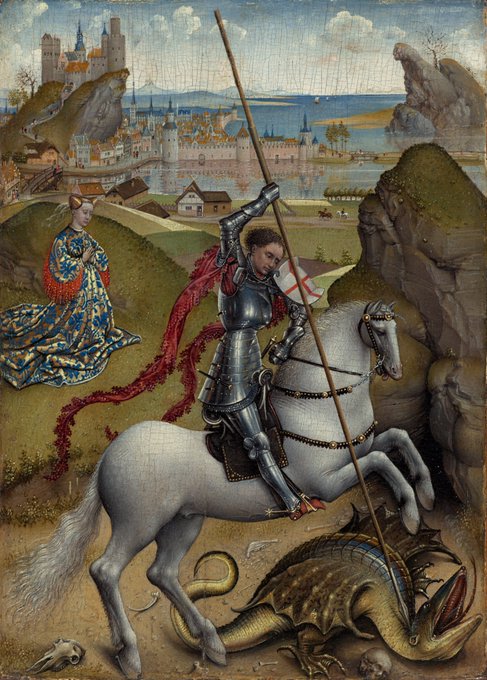The Rue de Parme is only a block long, so the location of the painting is easy to determine. Here’s a view of the street from 2019.
Across the street, a man walks with a cane as another figure stands on a ladder putting up the flag.
The harpooner appears as a secular version of Saint Michael defeating the devil or of Saint George fighting the dragon, a common legend depicted historically in painting.
Here’s an example from gallery 39 of Saint George by Rogier van der Weyden from circa 1432/1435.
😧The sailor at far left shows dread
😲The older sailor shows astonishment
😠The harpooner shows contempt
Painted around 12 years after the portrait of Sargent, this portrait of Tyng reveals changes in the Copley’s technique.
In Sargent's portrait he used thick layers of pigment in the face and hands. In Tyng’s, a more liquid paint allowed him to delineate details more precisely.
This arrangement includes *31* types of flowers, vegetables, and grains—some of which originated in places far from the Netherlands. Can you identify any?
Thanks for following along on today's tour!
If you want to learn more about American art from this period dive in to our Online Edition, “American Paintings, 1900–1945”: https://t.co/vGosVysfcQ
[Charles Sheeler, "Classic Landscape," 1931, oil on canvas]
By 1585, El Greco established a workshop in Toledo to fulfill his many commissions for churches in Spain.
“Saint Martin and the Beggar” (1600/1614) and “Madonna and Child with Saint Martina and Saint Agnes” (1597/1599) were made for the Chapel of Saint Joseph in Toledo.
While you may know Jackson Pollock and Mark Rothko, how familiar are you with the women of abstract expressionism? Gallery 407B includes Grace Hartigan’s “Essex and Hester (Red)” (1958) and Joan Mitchell’s “Salut Tom” (1979), a highlight of the Corcoran Collection. #5WomenArtists
There's also pet portraits!
Edouard Manet, “A King Charles Spaniel,” c. 1866
Edouard Manet, “Tama, the Japanese Dog,” c. 1875
Auguste Renoir, “Head of a Dog,” 1870
Henri de Toulouse-Lautrec, “The Artist's Dog Flèche,” c. 1881





















